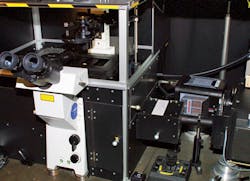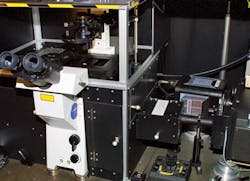CELL BIOLOGY/SPECTROSCOPY: Microspectroscopy setup enables direct monitoring of singlet oxygen in individual cells
Singlet oxygen, the first excited state of molecular oxygen, is a highly reactive species that plays an important role in a wide range of biological processes, including cell signaling, immune response, macromolecule degradation, and elimination of neoplastic tissue during photodynamic therapy (PDT). Now, researchers have developed an experimental setup that enables direct microspectroscopic monitoring of singlet oxygen.1
The Charles University (Prague, Czech Republic) scientists used two detection channels—visible and near-infrared (NIR)—to perform real-time imaging of the very weak NIR phosphorescence of singlet oxygen and photosensitizer simultaneously with visible fluorescence of the photosensitizer. Their experimental setup enables acquisition of spectral images based on singlet oxygen and photosensitizer luminescence from individual cells, where one dimension of the image is spatial and the other is spectral, covering a spectral range from 500 to 1700 nm.
To achieve these results, the researchers coupled a 2D-array indium gallium arsenide (InGaAs) camera with NIR sensitivity to an imaging spectrograph. The 2D detection array in the camera dramatically reduced acquisition times and helped to avoid some of the problems caused by photobleaching as compared to the group's previous 1D InGaAs detectors. A back-illuminated, silicon CCD camera was used to detect visible light in the setup.
The researchers indicate that the introduction of spectral images for such studies addresses the issue of a potential spectral overlap of singlet oxygen phosphorescence with NIR-extended luminescence of the photosensitizer and provides a powerful tool for distinguishing and separating them, which can be applied to any photosensitizer manifesting NIR luminescence.
1. M. Scholz, R. Dedic, J. Valenta, T. Breitenbach, and J. Hála, Photochem. Photobiol. Sci., 13, 1203–1212 (2014); doi:10.1039/C4PP00121D.

